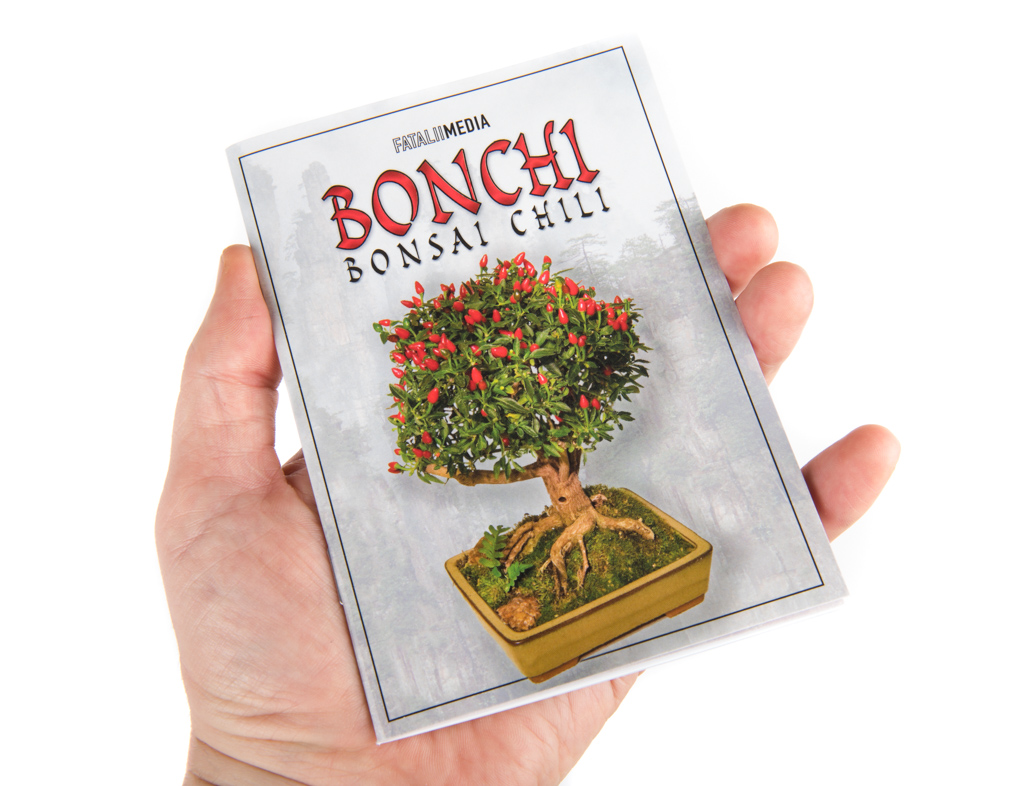Bonchi (Bonsai Chiles)
https://fatalii.net/bonchi
Welcome to the home of the bonsai chile peppers!
A form of truly enjoyable natural art & science!
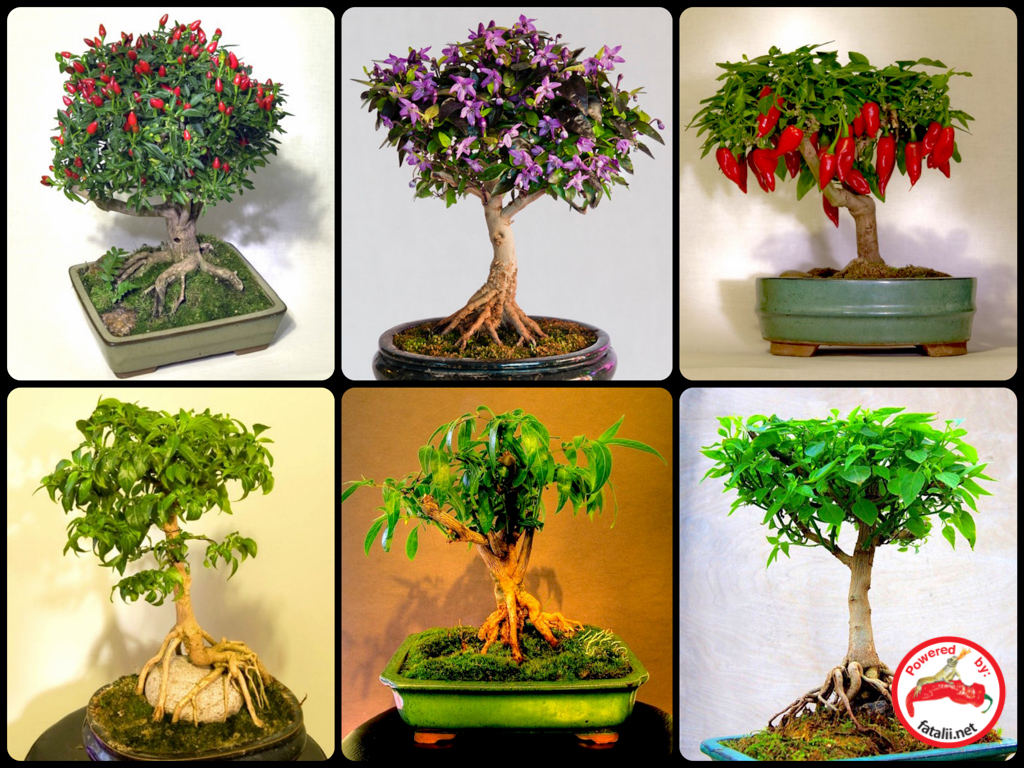
What can be more creative and versatile hobby and art than growing a chile pepper from a seed to a bonsai chile tree?
That’s what you can call your own creation!
Use all techniques available, growing thick stems, bending branches, adding stones, moss etc. and of course, trimming roots, leaves and stems just the way you like them.
First, you might think that “It takes too long for my patience to do that!“, but it’s actually very fast project with chile peppers, we talk about months here!… read on!
The best of all, you can choose ANY from thousands of completely different chile varieties to start your own chile bonsai project, truly from a seed!
If you want to get a full, comprehensive, 46 page bonchi guide in english, click the link below!
It ships all around the world!
Get the bonchi guide here
Seeds for the best bonsai chiles here:

https://fataliiseeds.net
Join the NEW FACEBOOK GROUP – Fatalii’s Bonchi (The Home Of Bonsai Chili)
And share your bonchi photos, ask anything and discuss with us!
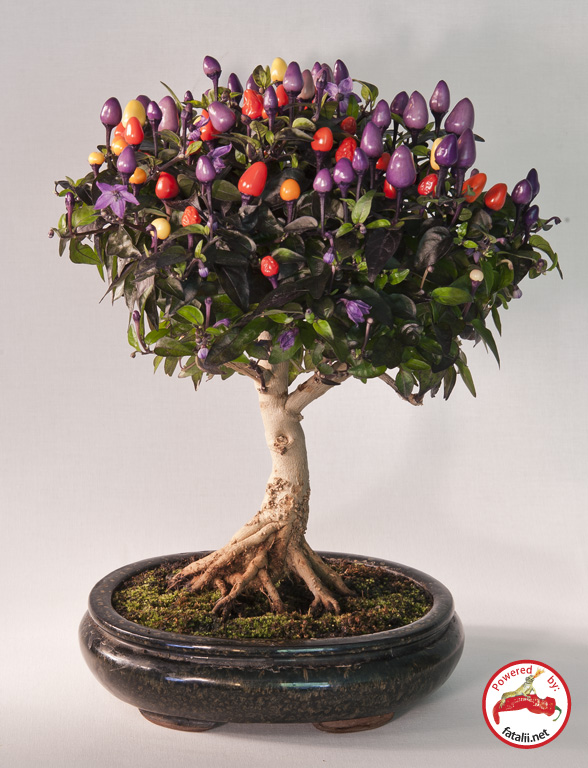
After receiving your seeds, the project is very simple, germinate them with the way you want.
Here’s a method I have used successfully for over a decade with thousands of different chile pepper varieties: https://fatalii.net/germinating
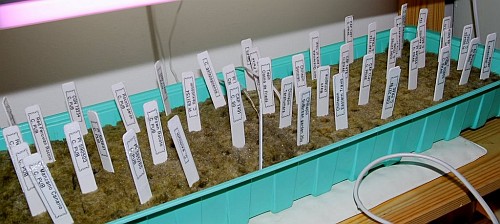
Germinating chiles. You can use soil or rockwool for example. I prefer rockwool and oasis because of their purity and ideal moisture preserving capabilities.
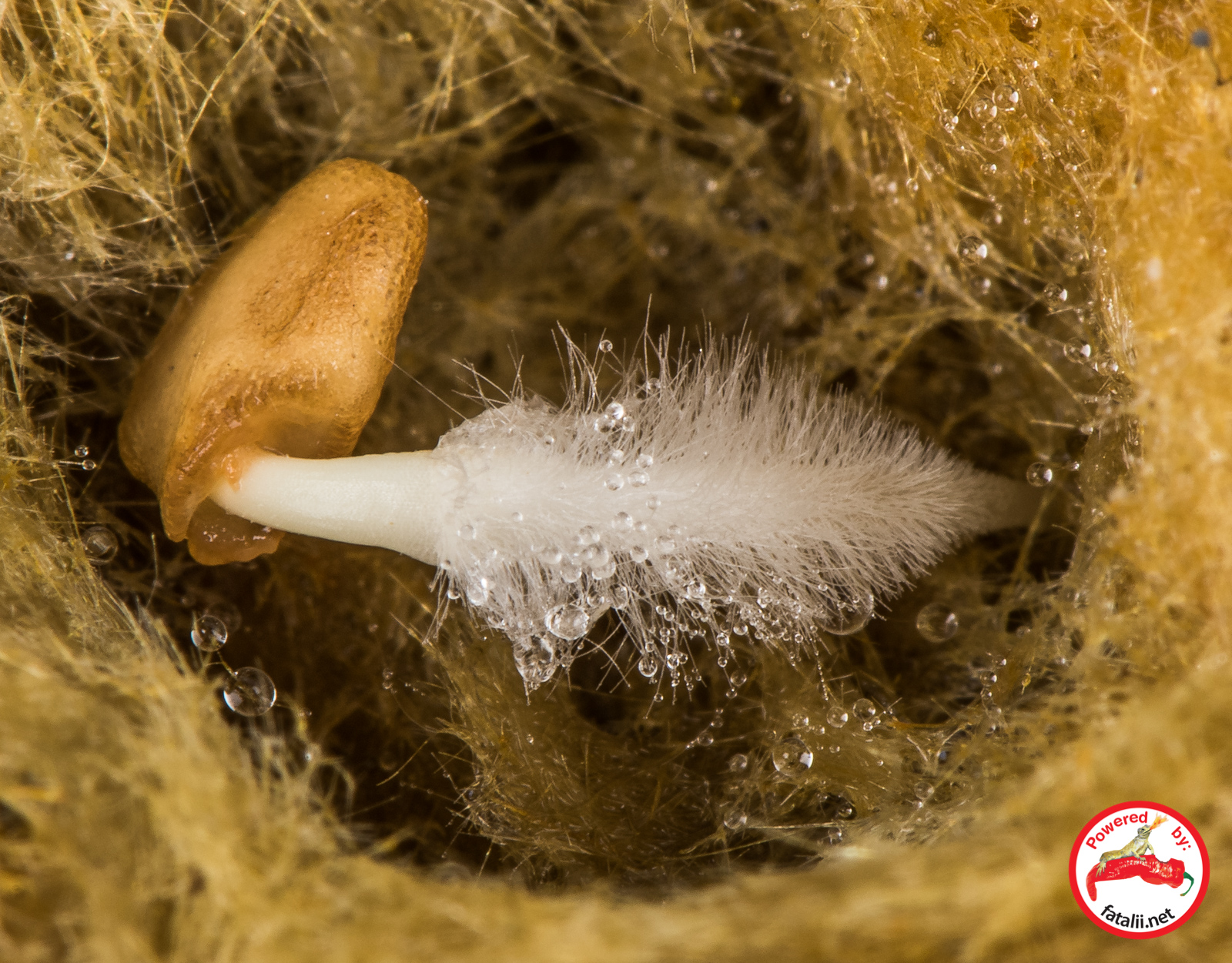
Seedling just germinated!
It doesn’t matter if the plant you selected grows 4 meters tall in a large container…
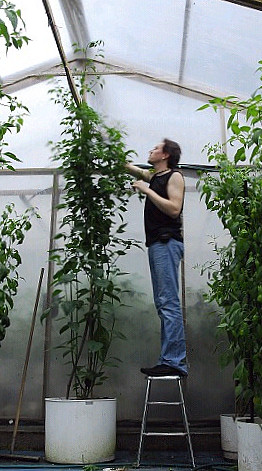
This plant actually reached 4 meters and yet it’s a perfect base for a bonsai-chile!
The magic as simple as it it is, happens here:
Just cut the plant down and repot it into a small bonsai pot (or into a temporary small pot at first).
Keep using scissors and small bonsai pot to keep your plant looking like a small tree!
In less than a year, you might already have collected a nice crop of chile peppers and have a great -looking chile bonsai with a thick, woody stem and branches!
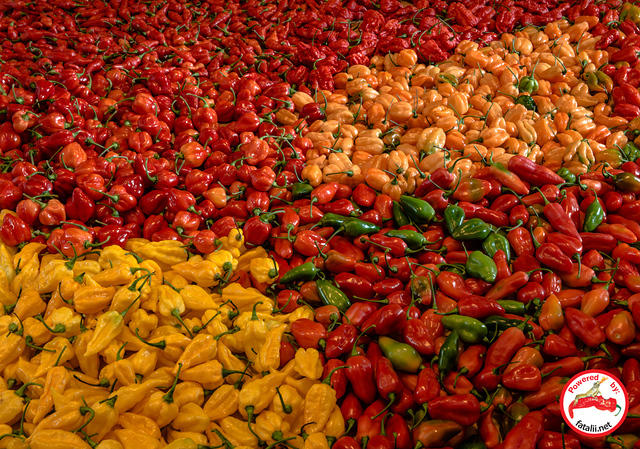
After harvesting your nice crop of your favorite chiles, it’s time to start the actual project!
The best way to succeed with bonsai chiles, grow a chile plant in a large pot at first. (Preferably outdoors), balcony and indoors will do too.
More info for the traditional chile pepper growing, check the growing section of the www.fatalii.net, direct link here.
You can also grow chiles hydroponically first, to hasten things even more, and then plant them into the bonsai pots.More info about hydroponic chiles here.
You can also grow your bonchis directly on small pots, but then the resuts of the stems won’t be as stunning as by growing the plants large at first.
One of the great things about bonchi-growing is that even if your yield for the season might not be what you expected, you can get plenty of joy from your favorite plants by turning them into bonchis!
You can also turn them back to “normal plants” whenever you want to just by planting them into larger containers once again.
Here’s one plant which was replanted to a bigger pot on a start of a season:
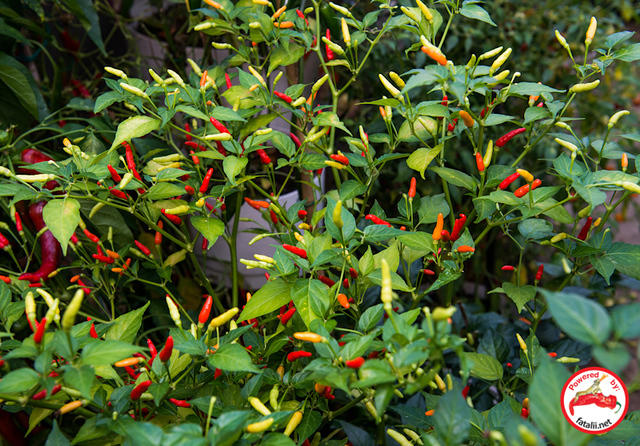
Aji Bravo (C. frutescens) after turning it back to “normal chile pepper plant” again
Read on to learn how to create your own bonsai chiles.
First, let’s cover some basics.
Creation of the bonchi
Okay, here we go:
: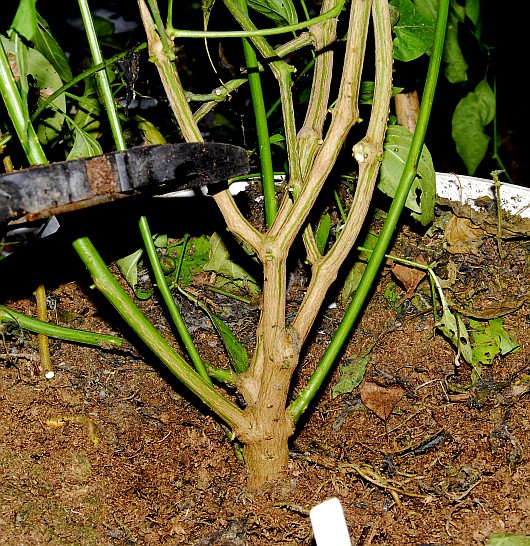
Cutting down the large plant to turn it into a small bonsai plant!
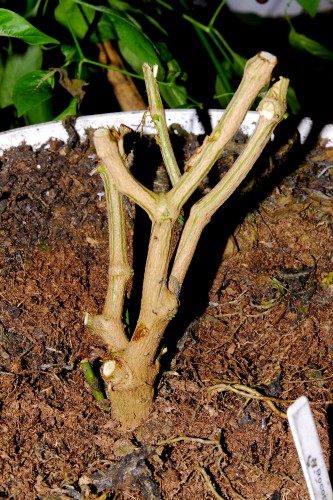
Cutted plant. Doesn’t look too good… just yet.
If possible, cut above the leaf-level to make sure your bonsai will continue growing, on the example here, there wasn’t any leaves below the cutting point so it’s a lot more risky process.
Or, you can trim the plant a little less, and continue the trimming when the plant is forming enough foliage later in the new pot.
Then cut off plenty of extra roots around the plant…
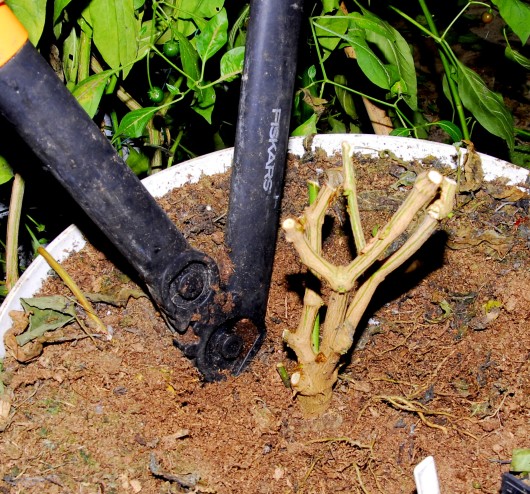
…and dig up the root ball…
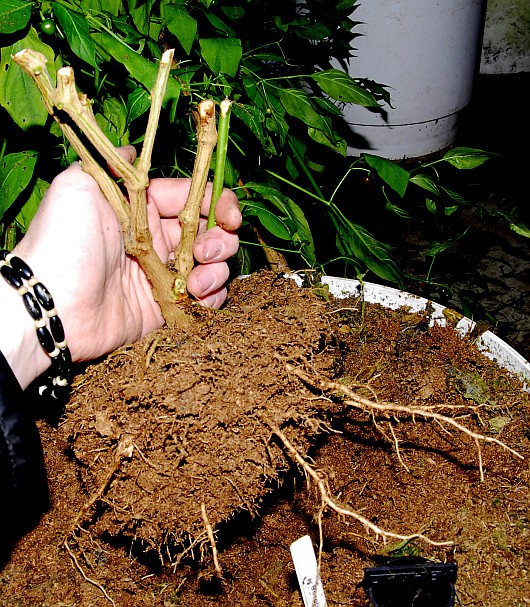
…and cut it small enough to fit in a preferred bonsai-pot.
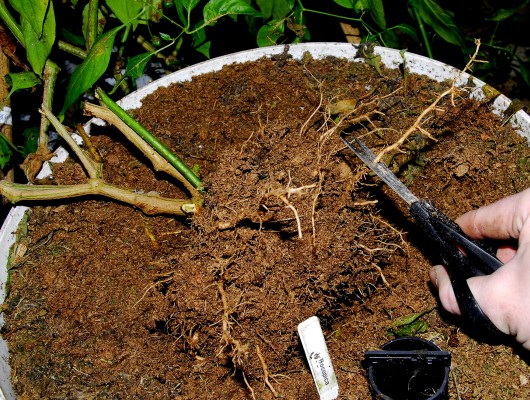
Trim the plant and the roots even more for the re-potting, if needed.
Then, add soil to the bottom of your bonsai pot.
At this point, it’s a good idea to clean up the upper parts of the roots from soil…
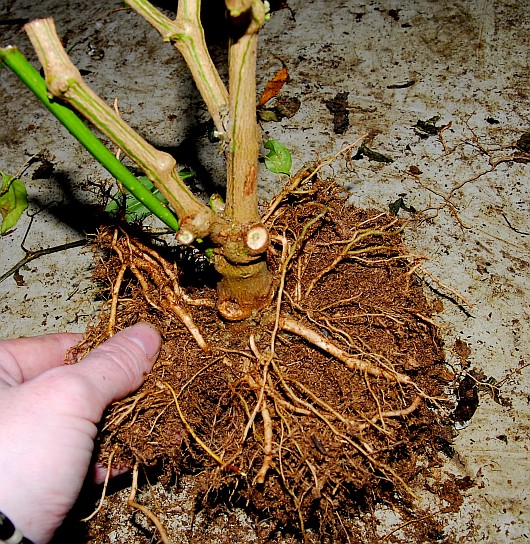
Removing some soil to make the roots more visible.
…the idea is to leave the largest roots visible above the soil level to make your bonsai chile to look more “dramatic”.
You can enhance this process by encouraging the woody root growth by exposing the largest roots for the light after in the middle of the growing season, preferably many months before cutting them down.
A few stem examples shown here from few of my full-sized plants:
(Keep in mind these will still grow for months before I will cut them down…)
Trimming the roots and repotting your bonchi into a bonsai pot
Cut off most of the smallest roots from the upper part of the chile roots… you can trim it even more after the chile bonsai has been planted to it’s new home.
This operation makes your bonsai chile look more like a small tree than a small chile plant.
A nice bonsai pot is highly recommended for the best looks!
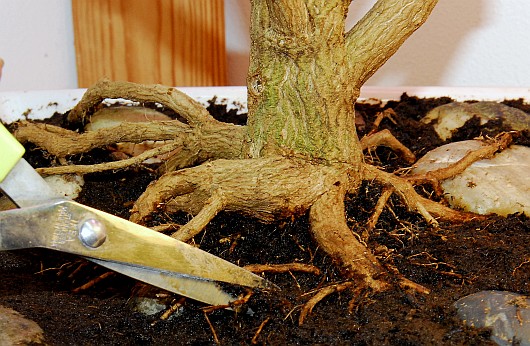
Trimming roots. Just leave the larger ones to show above the soil level to make it look better.
And then, plant your chile bonsai into it’s new bonsai-pot. Add some soil on the sides and around the stem and roots the way you want it.
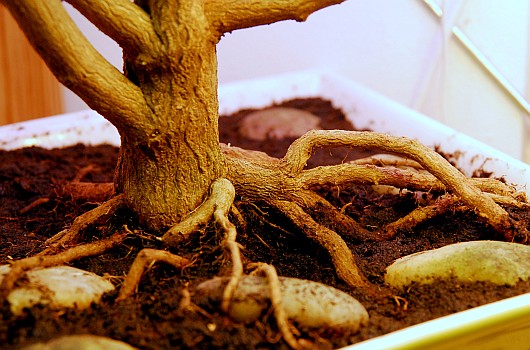
Designing the base for the bonsai.
Place the bonsai-stem (with not-too-much-foliage appearance at this point) on a sunny windowsill,
or for example under a fluorescent tube or bulb.
Light is the key for a new vigorous growth!
Keep in mind that as the enviroment and circumstances changed suddenly a LOT.
It might take a little while for your chile bonsai to grow some new roots and after that, hopefully some new foliage too!
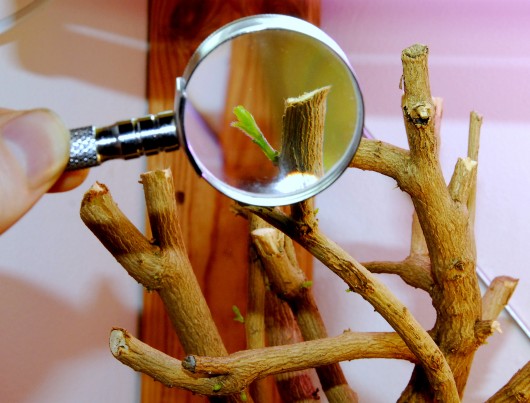
Finally! Some new growth!
The picture below shows several Bonchi’s growing their first leaves, right after cutting them down, yes they look ugly at this point, for a short while…
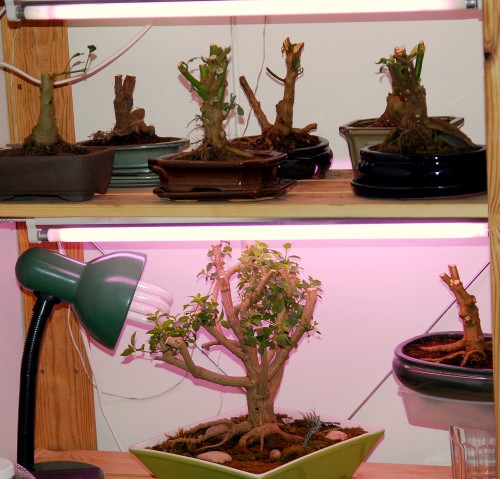
Later:
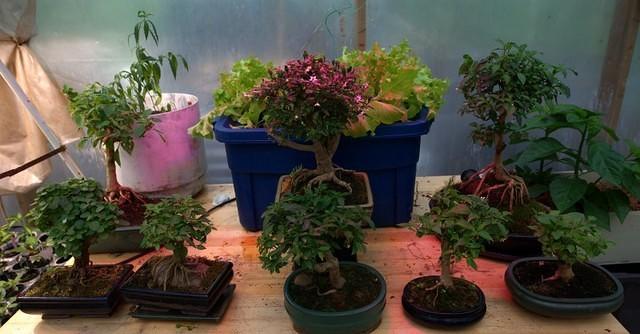
A group of bonchi’s on the table.
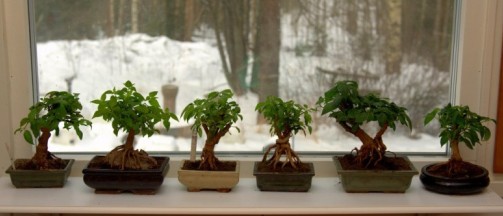
Bonchi’s on windowsill at winter.
Pruning your bonchi plants
Keep pruning the new growth (both stems and leaves) whenever needed to keep your bonsai growth very dense, this will make sure the new growth will look good. The most important tip about pruning comes here: Always cut off spindly branches without leaves.
Also remember that most often it’s a good thing (especially at the beginning), to keep pruning the plant a lot more that what you would think at first.
TIP: you can turn clipped branches into plants by rooting them! Here’s a link to a guide how to do that.
Fertilizing bonsai chiles
In larger pots, chiles won’t need too much fertilizing, but with bonsai chiles, the plant will consume the nutrients very quickly, so make sure to add some fertilizer like Fatalii’s Finest fertilizers every once in a while.
Decorating your bonchi plants
When you’re sure your bonsai is making some new growth, you can start decorating the surroundings of your bonsai chile, just to make sure you won’t decorate a dead plant.
Just use you imagination!
I like to make the chile plants look like a miniatyre trees.
Use stones, moss, lichens, pieces of wood, sand… just about anything you can think of to make your chile bonsai look as cool as possible!
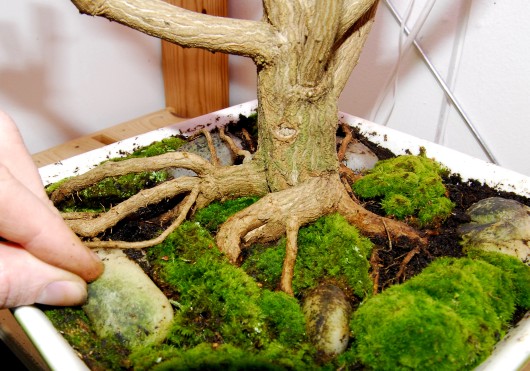
Adding some moss and few more stones. Still need to patch up some spots and add some details like small shrubs and weeds.
Also that hole in the stem needs some blackening, drilling it a little deeper would do the trick, but for now, I’ll just use a black pen. 🙂
It’s all about the details!
A decorating example here:

Wiring.
Pruning & wiring example, Dutch-Habanero.
It looks kinda good at first too, but I need to prune and wire it to get better looks for it to produce some yield.
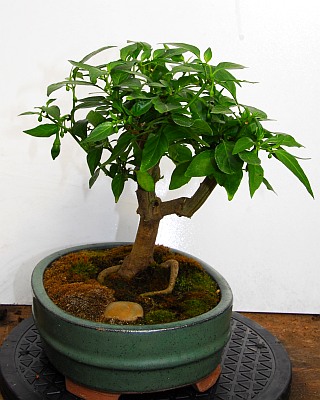
And here it`s wired and most big leaves removed.
Will look much, much better with more leaves, flowers and pods hanging there!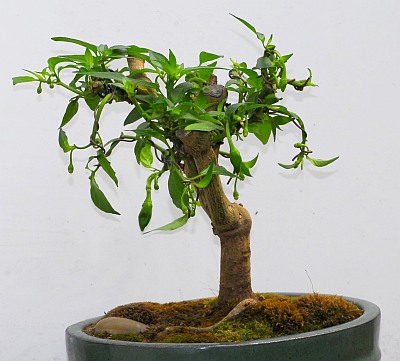
And here’s the same plant with pods later:
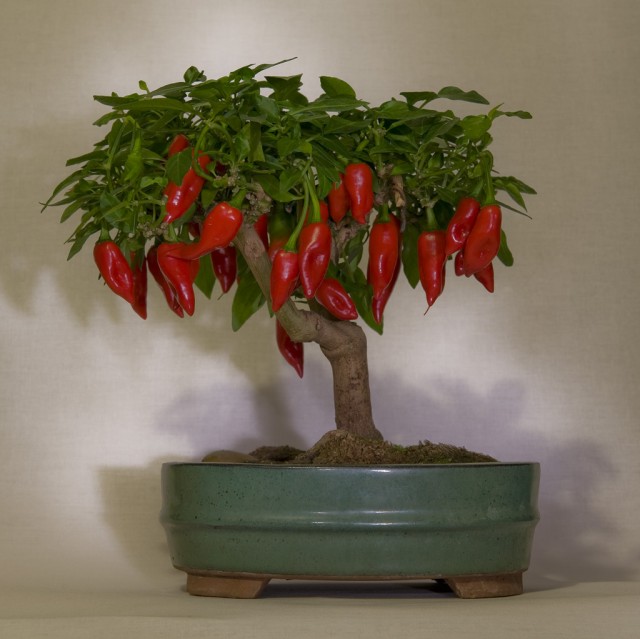
Dutch-Habanero F1 -bonchi.
Growing bonchi’s without growing large plants at first
This example isn`t a Bonchi with a woody stem,
but it shows what you can achieve very quickly with a cutting and a tiny pot:
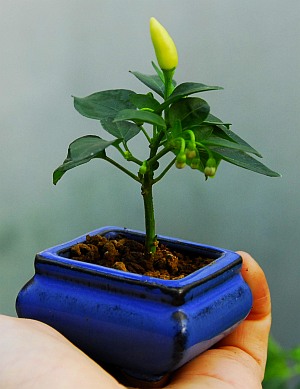
Many people have asked about growing Bonchi plants directly in a bonsai pots.
You can do that, but keep in mind that the whole idea is to grow as large plants (or just thick stems) as possible.
And that doesn’t happen quickly in a small pot.
That`s why I highly recommend growing chile plants normally at first.
Even when your plants are not in time to produce any yield, you can cut them down into Bonchi-shape.
Then grow them as ornamental Bonchi`s all winter long.
And after the winter, repot them into large pots and you`ll be very early for that season!
Bonchi’s indoors
 As indoor plants, bonchi’s are ideal for many reasons:
As indoor plants, bonchi’s are ideal for many reasons:
The amount of light
The light is usually problem with large plants as even the most effective lamps won’t cover the whole foliage of the plants.
The yields in most cases are quite poor when grown big chile pepper plants indoor because of the insufficient light.
With bonchi plants, even smaller energy saving fluorescent bulbs are enough to cover several bonchi plants! Just place the lamp close to bonchi plants, preferably middle of them. For example, one 30w fluorescent bulb can cover four bonchi plants so that they will produce good yields. For one large plant, that one lamp is not nearly enough.
In other words, you can get much better yield from small bonchi plants than with big plants indoors!
Pests
Growing large plants can be painful indoors if you get pests like aphids on your plants. There are no natural enemies for them indoors so the problem can grow severe very quickly. And large plants indoors infested with aphids or other pests can be a real pain in the ass. Trust me. I have been washing off the aphids from hundreds of plants indoorsand that is not certainly fun. In most cases you have to repeat that very often.
With bonchi’s, it’s a whole different story as all you need to do is to dip them into a bucket filled with pinetree soap to suffocate the pests. After a waiting for a 5-15 minutes, rinse of the soap water and you’re done, very quick and easy!
Preferably you can add some neem oil to prevent the pest infestions again, or even better, at all. Read this article from this link to learn more about pest control: https://fatalii.net/pests
The visuals
If you have grown large chile pepper plants, you know that in most cases, it isn’t very compelling visually.
Large plants tend to drop leaves and flowers. Some people can say they are ugly for decorating.
But then, bonchi’s are a whole different story.
Just take a look at the picture on the right.
Bonchi season is all year around!
Last but perhaps the most fun fact about bonchis is that you can grow them any time of the year!
Normally chile plants are ideal to be timed for mostly spring and summer.
Bonchi’s can be grown in the middle of the winter or any other time. And believe me, they can make your winter and rainy days much more fun! Gardening in the winter is very good for your mind while waiting for the spring!
Examples
Few pics to show how fast chile plants will grow very thick stems:
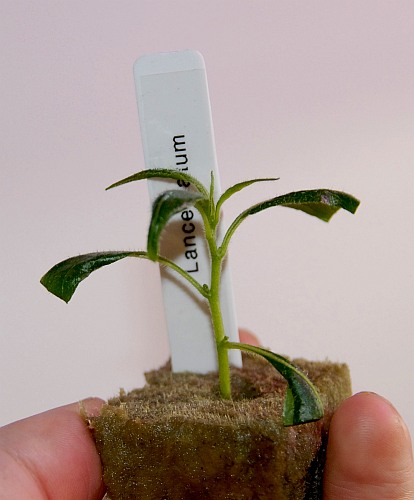
C. lanceolatum cutting 28th of march 2007
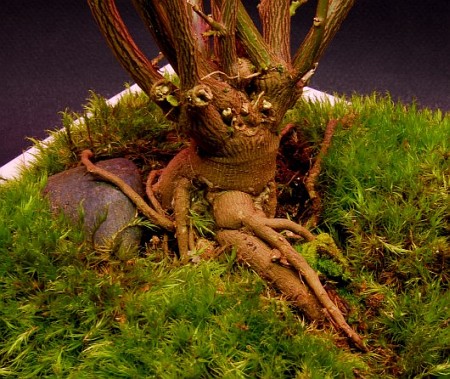
Same plant, 22th november, 2007, less than 8 months old!
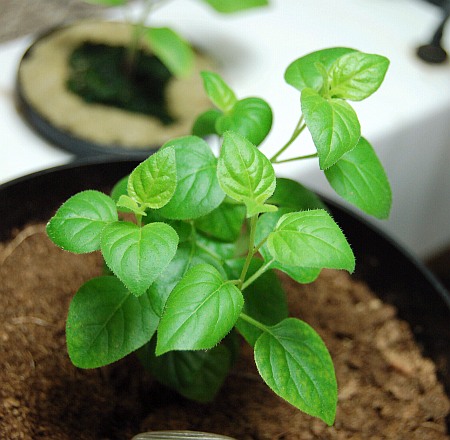
CGN 19198 (C. sp) germinated 1 month before the pic. (pic was taken 14th april, 2006)

Same plant, 22th of november, 2007, 1 year 7 months old plant.
Just think how it’ll look after few more years. 🙂
Some more bonchi examples
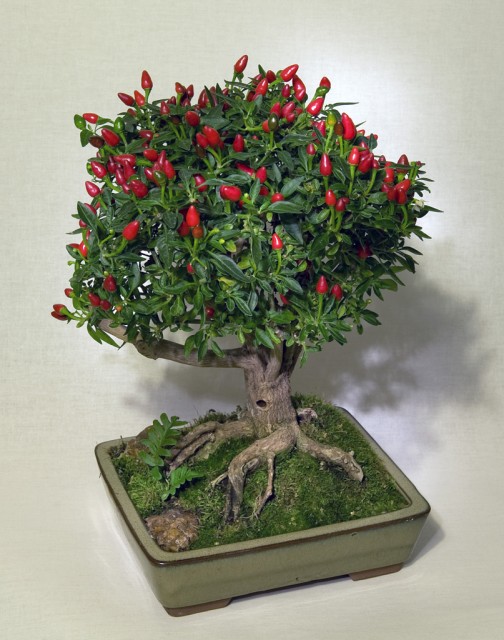
Bird’s Eye Baby -bonchi.
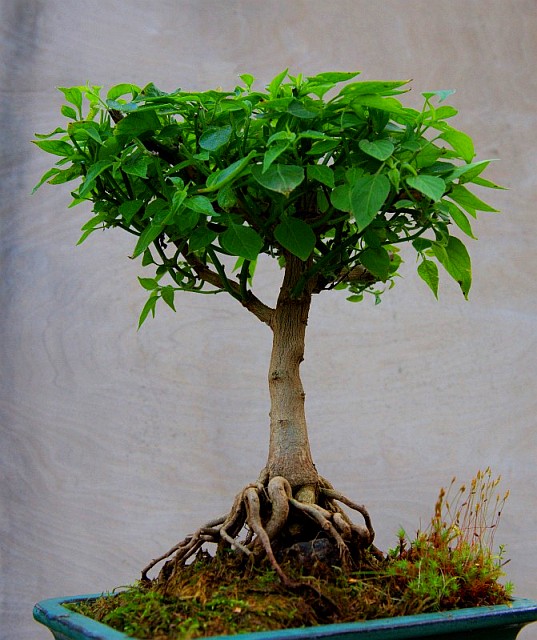
Cumari Pollux -bonchi.
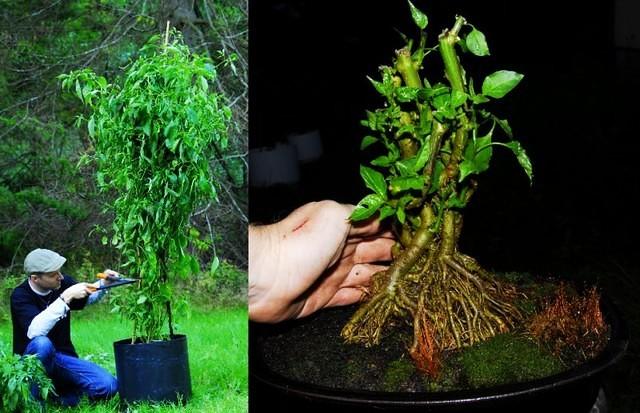
Before and after turning C. baccatum plant into a bonchi.
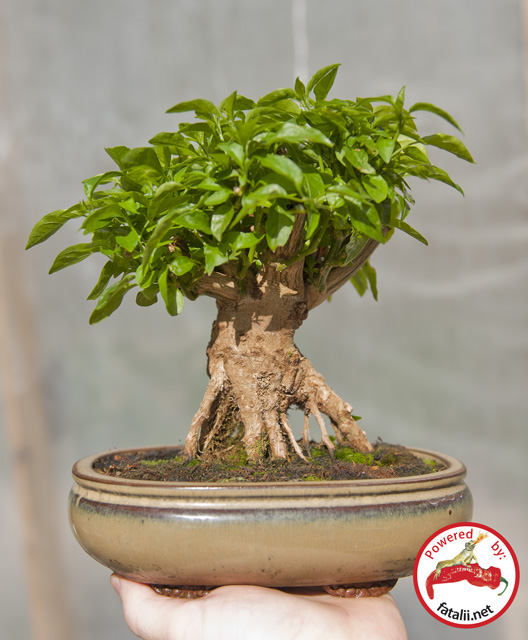
Tepin,National Park of Tikal, Guatemala -bonchi.
Start your project by getting the varieties you want. You can find the best varieties for bonchi growing from: https://fataliiseeds.net
It’s recommended to grow several plants for a better change to get a nice, thick complicated stem and roots! Try with different varieties of chile peppers as they give you greatly varying results.
Aaaarghhh!! Too much information at once!
In that case, here’s a summary of the most important things:
- Light is the key for a new vigorous growth! In fact the light is the key to the whole project to succeed, so provide light, as much as you can!
- The best way to succeed with bonsai chiles, grow a chile plant in a large pot at first. (Preferably outdoors), balcony and indoors will do too.
- You can also grow your bonchis directly on small pots but don’t expect as thick stems.
- Want to make sure your precious plant won’t die in the process? Provide some extra light near the bottom stem for a few weeks before cutting the plant down.
- At first, plant them into some cheap, regular small pots and repot them into bonsai pots when you are sure they have survived the process.
- If you are too afraid of cutting radically at once, you can trim the plant a little less, and continue the trimming when the plant is forming enough foliage later in the new pot.
- Always cut off spindly branches without leaves.
- In the early age of your bonchi -plant, keep pruning the plant a lot more that what you would think.
- With bonsai chiles, the plant will consume the nutrients very quickly, so make sure to add some fertilizer (like Fatalii’s Finest -series) every once in a while.
- Decorating your bonchi’s: It’s all about the details!
- Indoors: one 30w fluorescent bulb can cover four bonchi plants so that they will produce good yields.
- A great fact about bonchis is that you can grow them any time of the year!
- Keep in mind this important tip: there are NO RULES with Bonchi`s.
- HAVE FUN!
GO FOR IT, IT`S BOTH VERY FUN AND RELAXING.
One of the greatest hobbies.
So what now? I’m excited and I want to start growing my own bonchis!
Start below, with getting some seeds for ideal bonchi varieties and then look for some bonsai pots and equiment you might want.
Happy Bonchin’!
Seeds for the best bonsai varieties & other chile peppers here:
https://fataliiseeds.net
It ships all around the world!
Get the bonchi guide here

